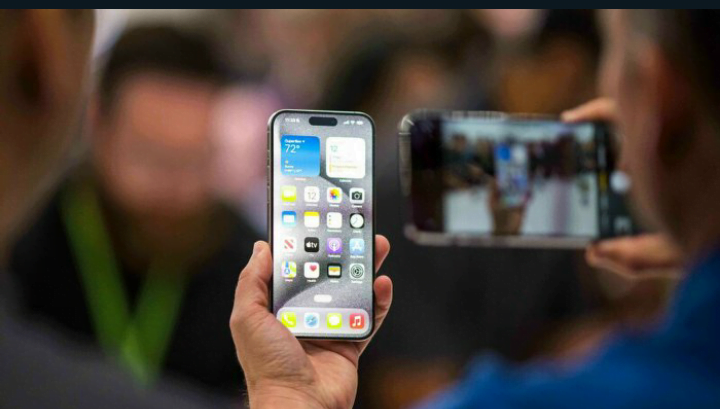In a highly-anticipated event hosted at Apple’s headquarters in Cupertino, California, the tech giant unveiled its latest iPhone 15 series, replete with a cutting-edge titanium shell, a swifter processor, and augmented gaming capabilities. What makes this release truly remarkable is the decision to maintain steady pricing, a strategic maneuver to navigate the challenging landscape of a global smartphone market in decline.
As the curtains lifted on this new iteration, the standout feature was the steadfast approach to pricing. In a smartphone industry rife with economic uncertainties, especially in vital markets like China, Apple opted not to escalate prices, a decision that resonates in an era of worldwide smartphone reticence.
The announcement arrives at a pivotal juncture, with China serving as Apple’s third-largest market. Here, the tech behemoth confronts formidable challenges, including amplified restrictions on the use of iPhones in government offices. Furthermore, Apple faces intensified competition from Huawei Technologies, which recently unveiled its first flagship phone in several years, the Mate 60 series smartphone, featuring satellite capabilities.
Apple’s event did not unveil any groundbreaking surprises, and the company’s shares concluded the day with a 1.7% decline.
While Apple refrains from explicitly mentioning artificial intelligence (AI), it is evident that machine learning underpins several new features. Apple’s executives elucidated the incorporation of machine learning to detect individuals within photographs. This innovation empowers users to effortlessly transform a picture into a portrait instantaneously or at their leisure within the Photos app.
Another noteworthy revelation pertained to Apple’s new watches, including the Series 9 Watch. This iteration introduces a distinctive feature named “double tap,” enabling users to execute tasks such as answering phone calls by tapping their thumb and finger together, without physical contact with the watch. The underlying technology employs machine learning to discern subtle variations in blood flow when fingers interact, liberating the other hand for tasks such as walking a dog or holding a cup of coffee, as elucidated by Apple’s Chief Operating Officer, Jeff Williams.
The iPhone 15 series, encompassing both the Pro and standard models, boasts an enhanced display with heightened brightness and a 48-megapixel camera. Additionally, the batteries within these devices incorporate 100% recycled cobalt, aligning with Apple’s commitment to sustainability.
Notably, Apple has introduced satellite connectivity in the iPhone 15, enabling users to summon roadside assistance. This feature will be implemented in collaboration with the American Automobile Association (AAA) in the United States.
Furthermore, Apple has announced the introduction of USB-C charging cables for the iPhone 15 and the charging case for its AirPods Pro. This strategic move is in compliance with European regulations mandating the use of USB-C and facilitates the utilization of the same charging cables employed for iPads and Macs.
Carolina Milanesi, an analyst with Creative Strategies, remarked on this shift, stating that it “brought some differentiation to the iPhone Pro, because there’s faster throughput for data transfer. That is going to be valuable for people,” especially professionals engaged in photography.
Additionally, Apple disclosed that the iPhone 15 Pro possesses the capability to capture “spatial videos” through the utilization of two cameras, resulting in three-dimensional video content. These spatial videos will be compatible with Apple’s forthcoming Vision Pro headset, slated for an early release next year, as highlighted by Apple’s marketing chief, Greg Joswiak.
One distinctive feature of the iPhone 15 Pro is its employment of titanium, rendering the device lighter and more robust compared to previous models crafted from alternative metals.
Bob O’Donnell, the head of TECHnalysis Research, expressed surprise at the sustained pricing strategy. He posited, “I think both Apple and the carriers recognize that with consumers feeling pressure on their budget and the lack of dramatic changes, it’s getting harder to convince people to upgrade. Keeping prices stable should help with that.”
In terms of pricing, the iPhone 15 is available at $799, the iPhone 15 Plus commences at $899, and the Pro series initiates at $999. The Pro Max, starting at $1,199, maintains the same price point as the preceding year for comparable storage capacities. Notably, last year witnessed the introduction of a $1,099 iPhone Pro Max variant with reduced memory.
Apple, while still dependent on iPhone sales for over half of its revenue, has navigated the shrinking global smartphone market astutely. Amidst a decline from shipping 294.5 million total phones to 268 million in the second quarter, Apple experienced the smallest drop in shipments among major smartphone manufacturers, decreasing from 46.5 million phones to 45.3 million, according to data sourced from Counterpoint Research.
In conjunction with its smartphone launch, Apple introduced new additions to its watch portfolio. The outdoor sports-focused Apple Watch Ultra 2 encompasses an array of new features tailored for cycling and diving. Notably, Apple claims that this watch is equipped with the brightest screen it has ever produced. The Series 9 will commence at $399, while the Ultra 2 watch will debut at $799, both becoming available on September 22.
A pivotal aspect of Apple’s presentation revolved around its commitment to sustainability. Lisa Jackson, the company’s environmental chief, announced that Apple will no longer incorporate leather in any of its products. Instead, the company will substitute certain items with a textile known as “FineWoven,” recognized for its suede-like texture.
In sum, Apple’s recent endeavors to attain carbon neutrality by 2030 took center stage at the event, exemplified by the launch of eco-conscious watches and the broader initiative to reduce the company’s carbon footprint.
Source, Reuters







